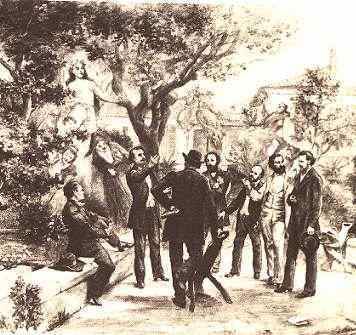 | ||
The Félibrige ([felibʁiʒ]; Lo Felibritge in classical Occitan, Lou Felibrige in Mistralian spelling, [lu feliˈβɾidʒe]) is a literary and cultural association founded by Frédéric Mistral and other Provençal writers to defend and promote Occitan languages and literature. However it is not to be confused with Occitanian organisations, as it defends cultural diversity within Southern France. It is presided over by a capolièr.
Contents
The word félibrige is derived from félibre, a Provençal word meaning pupil or follower.
Origins
Le Félibrige was founded at the Château de Font-Ségugne (located in Châteauneuf-de-Gadagne, Vaucluse) on 21 May 1854 (Saint Estelle's day), by seven young Provençal poets: Théodore Aubanel, Jean Brunet, Paul Giéra, Anselme Mathieu, Frédéric Mistral, Joseph Roumanille and Alphonse Tavan. Together, they aimed to restore the Provençal language and codify its orthography.
Its symbol is a seven-pointed star which, as Frederic Mistral writes in Lou tresor dóu Felibrige, is "a tribute to its seven founders".
They first applied themselves to the Provençal dialect of Occitan and the results of their efforts have been evident throughout Occitania since the end of the nineteenth century. Their presence can be discerned in Occitanian writers such as Michel Camélat and Simin Palav (Gascony and Béarn), Albert Arnavielle, Justin Bessou, Jacques and Gabriel Azaïs and Achille Mir (Languedoc), Arsène Vermenouze (Auvergne), Joseph Roux (Limousin), José Mange (Provence), and Charles Maurras.
The Félibrige is an organisation focussed on protecting and promoting Occitan language and culture, fighting for recognition of cultural diversity both within France and across the wider world. It is also one of the two organisations represented across Occitania since 1945, along with the IEO.
Capouliérs
Felebrigian festivals
There is a yearly meeting, which is called Santo Estello and held in a different town in the Pays d'Oc. The traditional banquet is ended with the ritual of the Copa Santa.
There are also other Fêtes Félibréennes:
The Jardin des Félibres in Sceaux
In 1950 Sceaux, Hauts-de-Seine (one of the Parisien banlieu) was named Cité Félibréenne. A memorial garden for this event was created around the tomb of Jean-Pierre Claris de Florian, a French poet and romancier, well known for his fables and a noted Félibrigist (perhaps because his mother was Castilian). The garden displays eleven busts in all.
The garden is located behind the church of Saint Jean-Baptiste (Saint John the Baptist) in Sceaux. The entry, signed: Parc de Sceaux, Jardin des Félibres is located on Avenue du Président Franklin Roosevelt in Sceaux.
